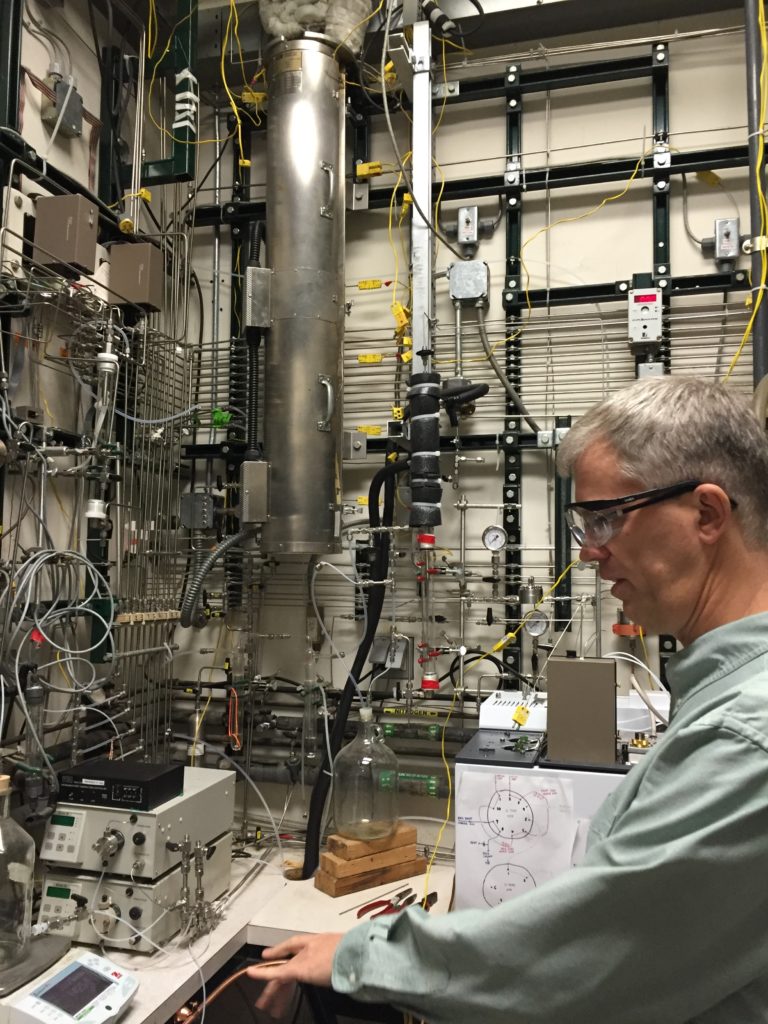OAK RIDGE, Tenn., Nov. 25, 2019 – A technology developed at the U.S. Department of Energy’s Oak Ridge National Laboratory and scaled up by Vertimass LLC to convert ethanol into fuels suitable for aviation, shipping and other heavy-duty applications can be price-competitive with conventional fuels while retaining the sustainability benefits of bio-based ethanol, according to a new analysis.
ORNL worked with technology licensee Vertimass and researchers at 10 other institutions on a technoeconomic and a life cycle sustainability analysis of the process – single-step catalytic conversion of ethanol into hydrocarbon blendstocks that can be added to jet, diesel, or gasoline fuels to lower their greenhouse gas emissions. This new technology is called Consolidated Dehydration and Oligomerization, or CADO.
The analysis, published in Proceedings of the National Academy of Sciences, showed that this single-step process for converting wet ethanol vapor could produce blendstocks at $2/gigajoule (GJ) today and $1.44/GJ in the future as the process is refined, including operating and annualized capital costs. Thus, the blendstock would be competitive with conventional jet fuel produced from oil at historically high prices of about $100/barrel. At $60/barrel oil, the use of existing renewable fuel incentives result in price parity, the analysis found.
The conversion makes use of a type of catalyst called a zeolite, which directly produces longer hydrocarbon chains from the original alcohol, in this case ethanol, replacing a traditional multi-step process with one that uses less energy and is highly efficient.
“The robustness of the catalyst enables direct conversion of wet ethanol, which greatly simplifies the process, reduces the cost of ethanol purification and makes hydrocarbon blendstock production costs competitive based on the analysis,” said Zhenglong Li, staff scientist for biomass catalysis at ORNL and a collaborator on the project.
While this single-step catalysis was effective at laboratory scale, further testing and improvements by Vertimass resulted in even higher product yields when scaled up 300 times using commercial catalyst formulations. The conversion operation could be integrated into new biofuels plants or installed as bolt-on technology to existing ethanol plants with minimal new capital investment, the researchers noted.
Advanced biofuels hold promise as clean-burning, carbon-neutral renewable energy sources. The goal is to create advanced liquid biofuels that can take advantage of existing pipeline delivery infrastructure and can be used in existing or advanced engines without loss of performance. The fuels are particularly attractive to help reduce net carbon emissions in heavy-duty engines such as those in aircraft, ships and large commercial vehicles where electrification is challenging.
Given current standards, the advanced biofuel could be blended at 20% with petroleum-derived jet fuel and somewhat higher for gasoline, subject to certification and verification.
Meanwhile, a life-cycle analysis of the conversion process found that its greenhouse gas emissions profile is similar to that for the ethanol fed to the process.
“The sustainability of bio-derived ethanol, now mostly produced from corn in the United States but with some now being made from corn stover and eventually dedicated biomass feedstocks like switchgrass, carries through with the catalytic process,” said Brian Davison, chief science officer for DOE’s Center for Bioenergy Innovation (CBI) at ORNL and a collaborator on the project. CBI is pursuing specific research targets for a thriving bioeconomy: sustainable biomass feedstock crops; advanced processes to break down and convert plants into specialty biofuels; and valuable bioproducts, including chemical feedstocks, made from the lignin residue after bioprocessing.
“Our scientists constantly push the boundaries of what’s possible to deliver breakthroughs for clean energy,” said Moe Khaleel, associate laboratory director for Energy and Environmental Sciences at ORNL. “The conversion of ethanol into hydrocarbon blendstocks takes advantage of an abundant domestic energy resource while supporting the development of thriving American bioeconomies.”
Refinements by Vertimass to the original, lab-scale process include the development of cheaper forms of the catalyst, as well as more than doubling the liquid fuel yield, the paper noted.
The paper details the refinements as well as results from analyses by Argonne National Laboratory, the National Renewable Energy Laboratory, Vertimass, and ORNL in collaboration with Dartmouth, the Federal Aviation Administration, Boeing, Pennsylvania State University, University of California-Riverside, Imperial College of London, the Brazilian Bioethanol Science and Technology Laboratory, and the Brazilian Center for Research in Energy and Materials.
“This research shows how ethanol, in addition to being a valuable fuel for cars, can be an effective intermediate for sustainable production of low-cost fuels for air travel and heavy-duty vehicles,” said professor Lee Lynd of Dartmouth College, who collaborated on the research and is the corresponding author. “The integration of biological and catalytic technologies shown here reflects the power of such hybrid systems.”
The initial discovery was supported by the Center for Bioenergy Innovation at ORNL, which in turn is supported by the DOE Office of Science. Scale-up research and development were supported in part by the DOE Office of Energy Efficiency and Renewable Energy and by Vertimass.
ORNL is managed by UT-Battelle for the U.S. Department of Energy’s Office of Science, the single largest supporter of basic research in the physical sciences in the United States. DOE’s Office of Science is working to address some of the most pressing challenges of our time. For more information, please visit https://energy.gov/science.
Original post https://alertarticles.info


